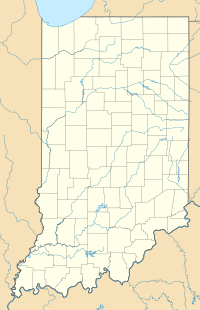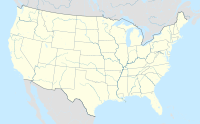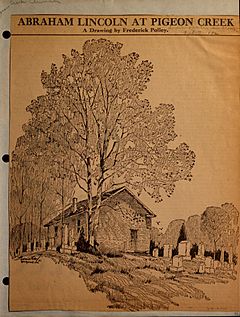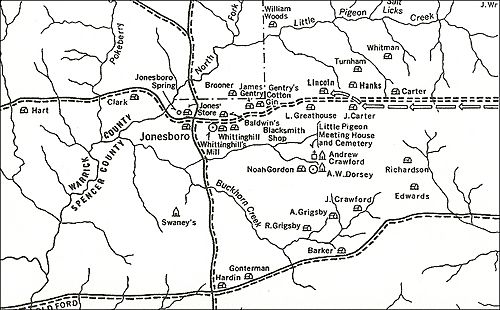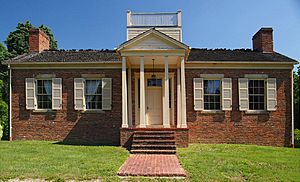Lincoln State Park facts for kids
Quick facts for kids Lincoln State Park |
|
|---|---|
|
IUCN Category III (Natural Monument)
|
|
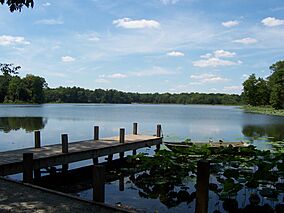
Lake Lincoln in Lincoln State Park
|
|
| Location | Spencer County, Indiana, United States |
| Nearest city | Lincoln City, Indiana |
| Area | 1,747 acres (7.07 km2) |
| Established | 1932 |
| Visitors | 234,226 (in 2018–2019) |
| Governing body | Indiana Department of Natural Resources |
Lincoln State Park is a special place in southern Indiana, United States. It's found in Spencer County, about 35 miles (56 km) east of Evansville.
The park opened in 1932 and covers 1,747 acres (707 ha). You can explore 10 miles (16 km) of trails here. Many buildings and fun areas in the park were built by the Civilian Conservation Corps. This group helped people find jobs during the Great Depression.
Inside the park, you'll find the Sarah Lincoln Woods Nature Preserve. There are also two lakes, places to camp, and cabins for groups. The park is close to many important spots from Abraham Lincoln's childhood. These include the Little Pigeon Creek Baptist Church and Cemetery. Lincoln's sister, Sarah Lincoln Grigsby, is buried there. You can also see the home of Colonel Jones, a Civil War officer who once employed Lincoln.
Memorials honor Lincoln's mother, Nancy Hanks Lincoln. Her grave is in the nearby Lincoln Boyhood National Memorial. The park also has a special center to learn more about Lincoln. About 235,000 people visit Lincoln State Park each year.
On April 8, 2024, the park was in the path of a total solar eclipse. Visitors saw the sun completely covered for 2 minutes and 5 seconds.
Contents
Exploring Lincoln's Childhood Home
Lincoln State Park offers a unique look into the early life of Abraham Lincoln. Many places here connect directly to his family and experiences.
The Little Pigeon Baptist Church
In 1820, Noah Gordon gave land for a church about a mile and a half from the Lincoln farm. Abraham Lincoln's father, Thomas Lincoln, helped build the Little Pigeon Baptist Church in 1821. Young Abraham, who was twelve, also helped his father. Thomas Lincoln even made the cabinets and pulpit inside the church.
This church was a "Hard Shell Baptist" church, also known as Primitive Baptist. It likely did not have a minister who went to college. Thomas Lincoln and his second wife, Sarah Bush Lincoln, joined the church in 1823. Thomas became a trustee a few days later.
Usually, only married adults could join the church. Abraham's sister, Sarah, joined in 1826, just before she got married. The Lincoln and Johnston children would stay home when their parents went to church. Later, Abraham himself attended services. In 1825, the church decided to build a cemetery next to it. The church was also a place for people to gather and socialize.
In 1840, some families, including the Grigsbys, left the church. They built a new Little Pigeon Baptist Church further south. They disagreed about Sunday school and mission work. Because of this, the original church became known as the Old Pigeon Church.
The church building you see today is part of the state park. It has a cornerstone from the original church. Next to the church is a small cemetery. This is where Lincoln's sister, Sarah Lincoln Grigsby, is buried. No church group worships there anymore.
Noah Gordon's Mill Site
The park also includes the spots where Noah Gordon's home and mill once stood. Noah Gordon was a neighbor of the Lincoln family. He had a small mill for grinding grain. Abraham Lincoln spent many hours waiting his turn to mill grain here. When he was nine, Abraham was kicked in the head by a horse at Gordon's mill. He was unconscious for several hours.
James Gentry's Home Site
Young Abraham Lincoln worked for James Gentry at his general store. You can find the site of James Gentry's home in Lincoln State Park, off of trail 3. Abraham Lincoln once took a flatboat trip to New Orleans for Gentry. He left from Rockport to sell goods. On this trip, Lincoln saw slavery for the first time.
Colonel William Jones's Home
The park also has the restored Colonel William Jones House near Gentryville. Colonel Jones was a merchant, farmer, and politician. He was also a Union Colonel during the American Civil War. His home was built around 1834. His farm included a general store where Abraham Lincoln also worked.
Colonel Jones was born in Vincennes in 1803. He moved to Spencer County in 1828. He and his wife, Rachel, raised five sons on this farm. You can take tours of the home, which includes a restored log barn. The home is located a quarter-mile west of Gentryville on Boone Street.
Lincoln Amphitheatre: Outdoor Performances
Inside Lincoln State Park is the Lincoln Amphitheatre. This is a modern outdoor theater with a roof. It was built in 1987. That year, it started showing a play called Young Abe Lincoln.
After closing in 2005, a new play, Lincoln: Upon The Altar of Freedom, opened in June 2009. This was for the 200th birthday of Lincoln. The play returned in 2010 and added "Concert in the Park." This featured cast members singing popular songs from Lincoln's time.
In 2011, Lincoln: Upon The Altar of Freedom became a musical called A. Lincoln: A Pioneer Tale. It told the story of Lincoln's childhood and big events during his presidency. It opened in June 2012 and played for three seasons. The amphitheater closed in 2015 for new management.
In 2016, the Indiana Department of Tourism ran the amphitheater. A Pioneer Tale played its fourth season, and many concerts took place. In 2017, a theater group from Jasper brought back Young Abe Lincoln for its 30th anniversary. It was performed again in 2018. In 2019, a new play called Here I Grew Up premiered. It had a new story and music.
Lincoln Interpretive Center: Learn About Nature
The Lincoln Interpretive Center is the park's nature center. It offers seasonal programs for visitors. You can also see exhibits about the natural history of the area.
See also


